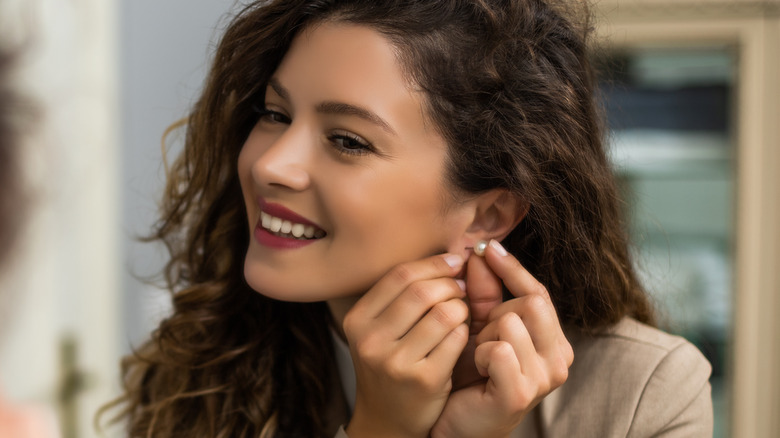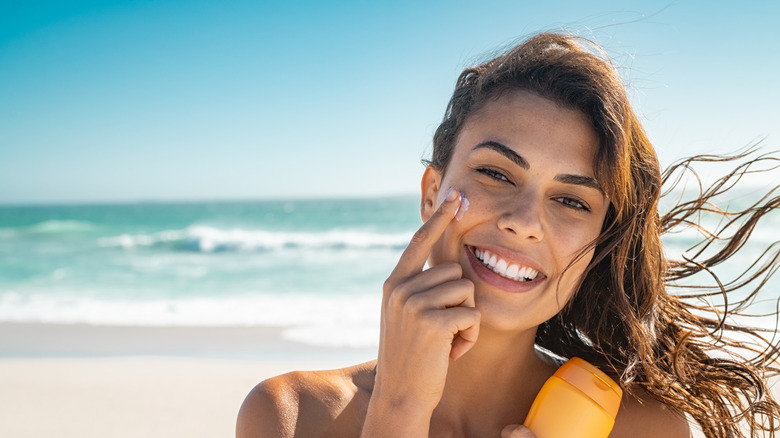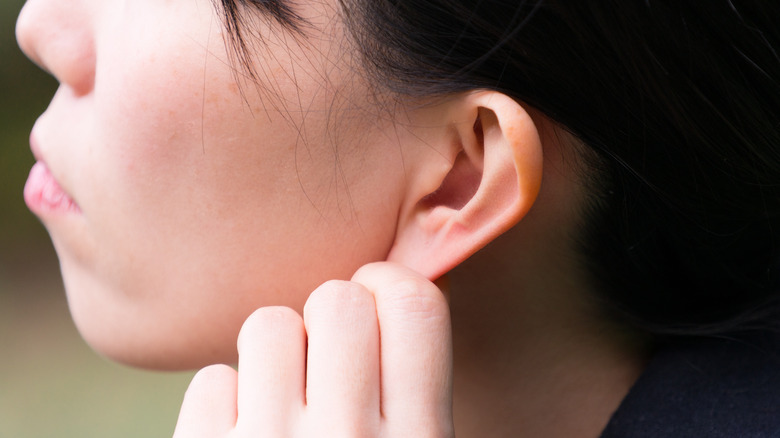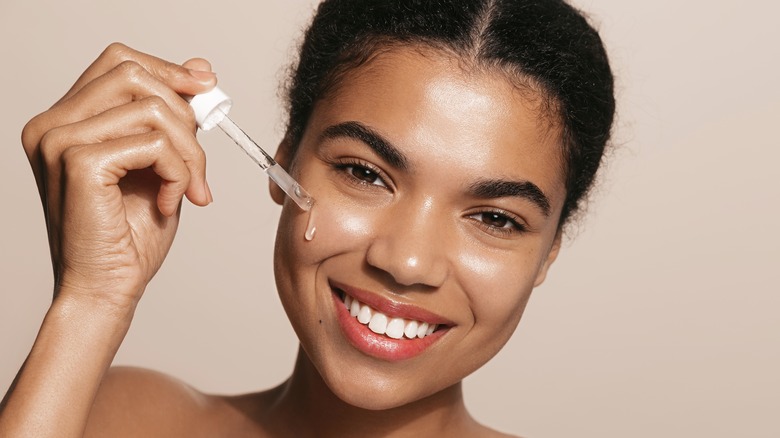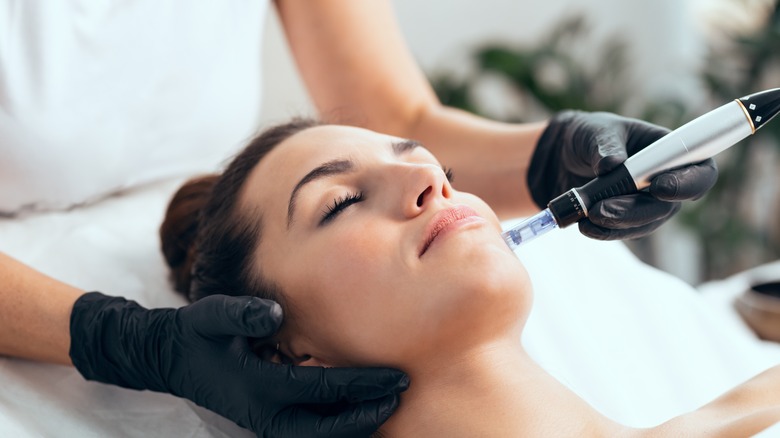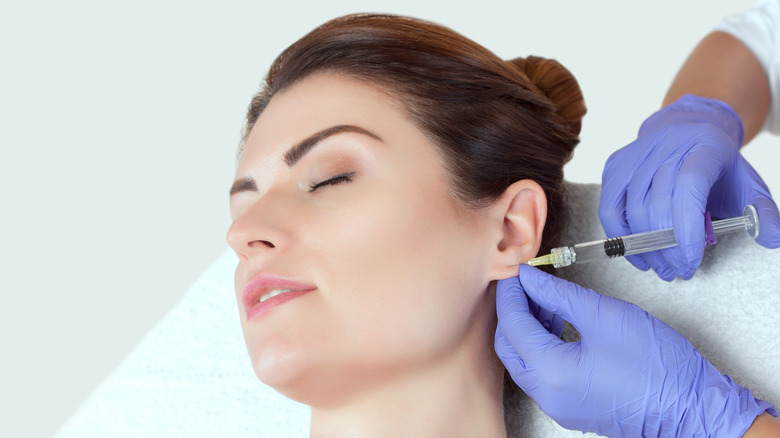Tips To Prevent Your Earlobes From Sagging
Worried about getting saggy earlobes later in life? Don't worry — many of us are! Earlobes may seem like a minor detail, but they play a crucial role in the overall aesthetics of the face. While saggy earlobes may not pose serious health risks, they can affect our self-esteem. Not to mention, saggy earlobes can make wearing those favorite hoop earrings so annoying! And excessively droopy earlobes can distract attention from other features, such as your amazing green eyes or charming smile. They can be a sign of aging, making you appear older than you are and affecting the symmetry of the face.
A healthy level of self-esteem is so important. It leads to increased confidence, positive decision-making, and improved relationships with others. On the other hand, low self-esteem can contribute to negative thoughts and behaviors, including anxiety and depression. Therefore, it's essential to prioritize building and maintaining a healthy level of self-esteem. So, if it means finding ways to prevent or fix sagging earlobes, we're not here to judge!
As we age, our skin loses elasticity due to decreased collagen and elastin production. The earlobes are not immune to this natural aging process and can become saggy. However, several factors, such as genetics, hydration, prolonged sun exposure, smoking, wearing heavy earrings over time, etc., can worsen sagginess. The good news is that several tips and tricks can help prevent your earlobes from becoming saggy.
Stay hydrated
Drinking water is vital for your skin and to keep it young and vibrant. Dehydration causes the skin to lose elasticity, leading to sagging. So, it's essential to drink plenty of water throughout the day. Drinking enough water helps to flush out toxins. When dehydrated, your body will prioritize hydration for your vital organs, leaving your skin to suffer and causing your skin to look dull, dry, and saggy.
The epidermis, which is the top layer of skin, loses elasticity when it is dehydrated. According to Westlake Dermatology, increasing your water intake can restore skin elasticity. When hydrated, your skin regains bounce, giving it a smoother, more youthful appearance.
Start your day with a glass of water, carry a reusable water bottle, and set reminders to drink water throughout the day! If you find drinking plain water boring, add a slice of lemon or cucumber for flavor. You can also eat fruits and vegetables with a high water content, such as watermelon, cucumber, and strawberries.
Protect your ears from the sun
We often overlook the skin on the ears for sun protection, yet it's thin and delicate, making it particularly vulnerable to sun damage. The sun's harmful UV rays can easily penetrate the skin on the ears and cause many problems, including premature aging and saggy earlobes.
One of the most effective ways to protect your ears from sun damage is to wear a hat outside for extended periods. Look for a wide-brimmed hat that provides good coverage, particularly over your ears and the back of your neck.
Another way to protect your ears from sun damage is to use sunscreen. Look for a broad-spectrum sunscreen with an SPF of 30 or higher, and reapply it every two hours or after swimming or sweating, even if you're outside for only a short period. According to research published in Clinical, Cosmetic and Investigational Dermatology, UV exposure causes up to 80% of facial aging! Protecting your ears from the sun can help prevent wrinkles and sagging, keeping your skin looking young and healthy.
Quit smoking
The chemicals in tobacco smoke cause premature aging and the effects are evident in the skin, leading to sagging skin all over the body, including the ears. According to research published in Tanaffos, smoking impacts the skin's density and thickness. The chemicals in cigarette smoke cause oxidative stress, damaging the skin's collagen and elastin fibers, leading to sagging and wrinkles. The effects of smoking on the skin are visible in many ways. The skin becomes rough, and the texture becomes uneven, with wrinkles and fine lines appearing much earlier than they would otherwise. The skin also loses its elasticity and becomes thinner, making it more vulnerable to damage from the environment, such as sun exposure.
However, there is always time to quit smoking and improve your skin's health and appearance! Your skin may look brighter and healthier within a few weeks of quitting smoking. As the body recovers from the damage caused by smoking, the skin becomes more elastic and youthful-looking, and the texture improves. Additionally, quitting smoking reduces the risk of developing skin cancer and other skin-related conditions. Quitting smoking isn't easy, but the benefits are enormous. Besides improving the skin's health and appearance, it also improves overall health and reduces the risk of heart disease, stroke, and lung cancer. Many resources are available to help smokers quit, such as nicotine replacement therapy, counseling, and support groups. The key is to keep trying and not give up, as quitting smoking is one of the best things you can do for your skin and overall health.
Moisturize regularly
Daily use of a high-quality moisturizer can keep your earlobes looking youthful. Moisturizers help keep the skin hydrated, soft, and supple, preventing sagging and maintaining elasticity. Moisturizing also prevents dryness and itching and reduces the appearance of fine lines and wrinkles. Many dermatology-friendly creams have excellent ingredients such as caffeine, hyaluronic acid, alpha-lipoic acid, and retinol, which specifically target the sagging caused by age.
As we age, our skin loses moisture, which can lead to dryness, flakiness, and sagging. A moisturizer replenishes lost moisture and keeps the skin soft and supple. When choosing a moisturizer for your earlobes, look for one specifically formulated for the delicate skin in that area. Some moisturizers may be too heavy or greasy, which can cause irritation or clog pores. If you're unsure and tired of researching (like many of us are), talk to a dermatologist who can direct you to the best moisturizers to purchase and save money while you're at it.
Avoid heavy earrings
Wearing heavy earrings can cause significant damage to your earlobes over time, causing stretching of the skin because the weight of the earrings pulls down on the earlobes, losing their elasticity and firmness. When you wear heavy earrings frequently, the skin and tissue in your earlobes can become stretched and damaged, and they sag and thin over time.
If you enjoy earrings, limit how often you wear heavy earrings and choose lighter options. Avoid wearing heavy earrings for extended periods; opt for lightweight ones that won't stress your earlobes. Wearing earrings with wider backs can reduce the risk of damage, too.
Another way to prevent saggy earlobes is to give your ears a break from wearing earrings, helping the tissue in your earlobes recover and regenerate. You can give your ears a break by removing your earrings at night, during exercise, or when you're at home relaxing. If you notice any signs of irritation, redness, or pain around your earlobes, take a break from wearing earrings and allow your skin to heal.
Massage your earlobes
Massaging your earlobes is a simple yet effective way to improve their firmness and prevent sagging. Furthermore, research published in PloS One stresses that skin massaging is a successful anti-aging technique! Collagen is a protein that provides structure and support to the skin, and as we age, our body's natural collagen production decreases, leading to sagging and wrinkles. Regular massaging can help increase blood flow to the area, stimulating collagen production and improving the skin's overall health.
To massage your earlobes, apply a moisturizer or oil to the area. Gently rub the earlobes between your fingers, using circular motions and light pressure. Massage for a few minutes daily, ideally in the morning or evening, when you apply moisturizer. You can use specialized tools to massage the earlobes, such as facial rollers and gua sha tools. These tools stimulate circulation and promote lymphatic drainage, which can help to reduce inflammation and improve the appearance of saggy skin.
Get plenty of sleep
Getting enough sleep is crucial for overall health and well-being and essential for maintaining healthy, youthful-looking skin, including your earlobes. When you sleep, your body repairs and regenerates skin cells, and lack of sleep can disrupt this process, leading to a dull, tired-looking complexion. In addition, when you are sleep-deprived, your body produces more cortisol, a stress hormone that can contribute to the breakdown of collagen, a protein that provides structure and support to the skin. Collagen is essential for maintaining firm, elastic skin; the skin becomes saggy and loose when it breaks down.
According to a study published in the Journal of Clinical Sleep Medicine, poor sleep quality is associated with increased signs of aging, including fine lines, wrinkles, and uneven pigmentation. Sleep deprivation can also weaken the skin's barrier function, making it more susceptible to damage from environmental factors such as pollution and UV rays. Aim for seven to nine hours of restful sleep each night to ensure you get enough. Creating a relaxing bedtime routine, such as taking a warm bath or reading a book, helps you unwind and prepare for sleep. Avoid using electronic devices before bed, as the blue light they emit can disrupt your sleep cycle. If you have trouble falling or staying asleep, try relaxation techniques such as deep breathing or meditation.
Avoid sleeping in earrings
While it may be tempting to leave your earrings overnight, sleeping in them can lead to various issues, including sagging earlobes, headaches, infections, and allergic reactions. When you sleep in earrings, the pressure from the earrings can cause the earlobes to be pressed against the pillow, leading to damage and stretching of the tissue. Over time, this can contribute to sagging earlobes and even make it uncomfortable to wear earrings. Sleeping in earrings also leads to headaches because the pressure from the earrings causes tension and discomfort around the ears.
Sleeping in earrings also increases the risk of infections and allergic reactions. Wearing earrings for an extended period can trap dirt, bacteria, and sweat against the skin. Similarly, if you have sensitive skin or an allergy to certain metals, sleeping in earrings increases your risk of developing an allergic reaction. If you must wear earrings overnight, opt for lightweight, comfortable options that won't put too much pressure on your earlobes. It's also crucial to clean your earrings regularly to prevent the buildup of bacteria and other harmful substances.
Use collagen supplements
Collagen is a vital protein that forms the structural foundation of the skin, bones, and connective tissues. It is responsible for providing strength and elasticity to the skin, which makes it look young and healthy. However, as we age, our body's ability to produce collagen decreases, resulting in wrinkles, fine lines, and sagging skin. As a result, many people turn to collagen supplements to improve the appearance of their skin.
Collagen supplements come in various forms, including pills, powders, and drinks. They are made from animal or fish sources and are rich in amino acids, essential for body collagen production. Regular collagen supplements can help boost collagen levels in the skin, leading to smoother, more hydrated, and elastic skin. It can also help reduce the appearance of fine lines and wrinkles. As we age, our earlobes lose elasticity, causing them to sag. Collagen can help boost the skin's elasticity, including the skin on the earlobes, which can help keep them looking firm and youthful. Collagen supplements promote new tissue growth, speeding up healing and reducing scarring, which is helpful for people who have suffered from injuries or have undergone surgery and need to regenerate damaged tissues.
Consider cosmetic procedures
Sagging skin is a common concern for many people; fortunately, several cosmetic procedures can help restore a youthful appearance. Earlobe rejuvenation surgery, for example, helps restore the formation of a saggy ear. This procedure involves removing excess skin and tissue from the earlobe and reshaping it to a more youthful, firm appearance.
Earlobe rejuvenation surgery is a quick and relatively painless procedure done in a dermatologist or plastic surgeon's office. The surgeon will make a small incision in the earlobe during the procedure and remove any excess skin or tissue. They will then reshape the earlobe and close the incision with sutures. The procedure usually takes less than an hour and can be done under local anesthesia, but consult a professional before undergoing any cosmetic procedure. A dermatologist or plastic surgeon can evaluate your skin and recommend the best treatment. Seeing a dermatologist before a cosmetic procedure is important to ensure safety, minimize risks, and achieve optimal results.
Consider earlobe fillers
Earlobe fillers are a non-invasive cosmetic procedure that can help prevent sagging earlobes. Earlobes can lose their elasticity and firmness as we age, resulting in a saggy appearance. Earlobe fillers help restore volume and plumpness to the earlobes. The procedure involves injecting a filler into the earlobe using a small needle. The filler used for earlobe fillers is usually made of hyaluronic acid, a natural substance found in the body that helps hydrate and plump the skin. The filler is injected into the earlobe in small amounts, and the procedure is relatively painless and quick, usually taking no more than 15 to 20 minutes.
Earlobe fillers are a safe and effective way to prevent sagging earlobes. The procedure results are immediate, with no downtime or recovery period. The results of earlobe fillers can last up to a year, depending on the type of filler used and the individual skin type. One of the main advantages of earlobe fillers is that they are a non-invasive alternative to surgery. Unlike earlobe rejuvenation surgery, which involves making incisions and removing excess skin, earlobe fillers do not require incisions or cutting.
Exercise regularly
Regular exercise provides numerous benefits, including improved cardiovascular health, increased strength, and weight management. However, activity impacts the skin, the body's largest organ. One of the benefits of regular exercise is improved blood flow and oxygenation to the skin. This improved blood flow can help prevent sagging earlobes.
Good blood flow to the skin is critical in preventing sagging earlobes. Regular exercise improves blood flow and oxygenation, keeping the skin firm and healthy. According to research in Dermatology Reports, exercise prevents dryness and other skin problems. Dry skin is a common problem, especially during winter, but regular exercise helps keep the skin hydrated and healthy. Regular exercise also helps the skin retain moisture. Experts recommend at least 30 minutes of daily activities like walking, jogging, and cycling. If you're feeling ambitious, aim for an hour a day of exercise, whether dancing, swimming, or rock climbing. Exercise doesn't have to be boring.
Eat a healthy diet
A healthy and balanced diet is essential for maintaining overall health and youthful-looking skin. A diet rich in fruits, vegetables, and healthy fats can provide the nutrients your skin needs to look its best. Fruits and vegetables are packed with vitamins and antioxidants that protect your skin from damage caused by free radicals. These free radicals are unstable molecules that can damage skin cells, leading to premature aging, wrinkles, and sagging skin.
Healthy fats such as monounsaturated fatty acids (MUFAs) in foods like olive oil can also significantly impact skin health. A PLoS One study found that people who consumed a diet high in MUFAs had a lower risk of developing severe skin aging. The antioxidants in olive oil have anti-inflammatory qualities that help reduce inflammation in the skin, which is a common cause of skin aging. On the other hand, you should avoid processed foods and sugar, as they contribute to skin damage and aging. Processed foods are typically high in refined carbohydrates, which lead to inflammation and oxidative stress in the body. Additionally, sugar consumption causes collagen and elastin fibers to become stiff and brittle, leading to sagging skin.
Try an earring-stabilizing sticker
Earring-stabilizing stickers are a simple and effective solution for people who experience sagging earlobes due to the weight of their earrings. These small, adhesive stickers can be placed on the back of the earring post, creating a cushion that helps distribute the weight of the earring more evenly, preventing the earlobe from stretching or sagging over time.
The stickers are made from soft, flexible materials, such as silicone or foam, which are gentle on the skin and comfortable to wear. They come in various shapes and sizes, so you can choose the ones that best fit your earrings and earlobes. Using earring-stabilizing stickers is easy. Remove the sticker from its backing and apply it to the back of the earring post. The sticker will create a secure, stable base for the earring. One benefit of earring-stabilizing stickers is that they are discreet and virtually invisible. Unlike other types of earring backs, such as plastic or metal backs, the stickers do not detract from the appearance of the earring. They're also reusable so you can use them repeatedly with different earrings.
